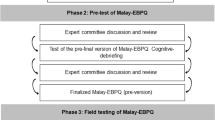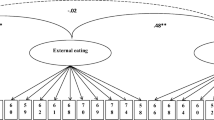Abstract
OBJECTIVE: This paper describes the creation and demonstrates the internal consistency of the Attitudes and Patterns of Eating (APE) Questionnaire, English version, which assesses adolescent food beliefs and eating habits and can be used for comparative studies on various cultures and lifestyles. The questionnaire is intended for use in a study comparing French and U.S. adolescents, the details of which will be presented in a future article. METHOD: A research team composed of French and American researchers observed eating behaviors in community samples from each country and reviewed previous studies comparing Europe and North America regarding eating attitudes/practices. Common eating-related themes were identified and corresponding questionnaire items were constructed, then a group of U.S. high school students (N=1230) was administered the questionnaire. RESULTS: A principal components analysis (PCA) identified 5 components: “Eating Diet/Light Foods,” “Unhealthy/Increased Eating,” “Homemade Meals,” “Skipping Meals” and “Healthy Eating”. DISCUSSION: The testing and factor analysis of the APE (English) Questionnaire demonstrated its internal consistency. Further validity and reliability studies will be needed to complete the global validation process for both the French and English versions.
Similar content being viewed by others
References
Goldschmidt AB, Aspen VP, Sinton MM, et al. Disordered eating attitudes and behaviors in overweight youth. Obesity (Silver Spring) 2008; 16: 257–64.
Wilson GT, Perrin NA, Rosselli F, et al. Beliefs about eating and eating disorders. Eating Behav 2009; 10: 157–60.
van Hoeken D, Seidell J, Hoek HW. Epidemiology. In: Treasure J, Schmidt U, van Furth E (Eds) The Essential Handbook of Eating Disorders. Wiley & Sons Ltd, 2005, pp 11–34.
Hoek HW, Vandereycken W. Eating disorders; 25 years of research and treatment. Tidjdschr Psychiatr 2008; 50: 85–9 (Article in Dutch).
Wang Y. Child Obesity and Health. International Encyclopedia of Public Health 2008; 590–604.
Crossman A, Sullivan DA, Benin M. The family environment and American adolescents’ risk of obesity as young adults. Soc Sci Med 2006; 63: 2255–67.
Chaloupka FJ, Johnston LD. Bridging the gap: research informing practice and policy for healthy youth behavior. Am J Prev Med 2007; 33: S147–61.
Koplan JP, Liverman CT, Kraak VI. Preventing childhood obesity: health in the balance: executive summary. Committee on prevention of obesity in children and youth. J Am Diet Assoc 2005; 105: 131–8.
Hudson JI, Hiripi E, Pope HG, et al. The prevalence and correlates of eating disorders in the National Comorbidity Survey Replication. Biol Psychiatry 2007; 61: 348–58.
Neumark-Sztainer DR, Wall MM, Haines JI, et al. Shared risk and protective factors for overweight and disordered eating in adolescents. Am J Prev Med 2007; 33: 359–69.
Dietz WH. Health consequences of obesity in youth: childhood predictors of adult disease, Pediatrics 1998; 101: 518–25.
Haines J, Neumark-Sztainer D. Prevention of obesity and eating disorders: a consideration of shared risk factors. Health Educ Res 2006; 21: 770–82.
Neumark-Sztainer D. Can we simultaneously work toward the prevention of obesity and eating disorders in children and adolescents? Int J Eat Disord 2005; 38: 220–7.
Burgess-Champoux TL, Larson N, Neumark-Sztainer D, et al. Are family meal patterns associated with overall diet quality during the transition from early to middle adolescence? J Nutr Educ Behav 2009; 41: 79–86.
McLaughlin C, Tarasuk V, Kreiger N. An examination of at-home food preparation activity among lowincome, food-insecure women. J Am Diet Assoc 2003; 103: 1506–12.
Larson NI, Story M, Eisenberg ME, et al. Food preparation and purchasing roles among adolescents: associations with sociodemographic characteristics and diet quality. J Am Diet Assoc 2006; 106: 211–8.
Larson NI, Perry CL, Story M, et al. Food preparation by young adults is associated with better diet quality. J Am Diet Assoc 2006; 106: 2001–7.
Larson NI, Neumark-Sztainer DR, Harnack LJ, et al. Fruit and vegetable intake correlates during the transition to young adulthood. Am J Prev Med 2008; 35: 33–7.
Bauer KW, Larson NI, Nelson MC, et al. Fast food intake among adolescents: secular and longitudinal trends from 1999 to 2004. Prev Med 2009; 48: 284–7.
Rozin P. The meaning of food in our lives: a cross-cultural perspective on eating and well-being. J Nutr Educ Behav 2005; 37: S107–12.
Rozin P. Why we’re so fat. Psychol Today 2000; 33: 64–6.
Rozin P, Geier AB. Want fewer fries with that? Chronicles of Higher Education 2007; 53: 1.
Rozin P, Fischler C, Imada S, et al. Attitudes to food and the role of food in life in the U.S.A., Japan, Flemish Belgium and France: possible implications for the diethealth debate. Appetite 1999; 33: 163–80.
Rozin P, Fischler C, Shields C, et al. Attitudes towards large numbers of choices in the food domain: a crosscultural study of five countries in Europe and the U.S.A. Appetite 2006; 46: 304–8.
Clark PP. Thoughts for food, I: French cuisine and French culture. The French Review 1975; 49: 32–41.
Musher-Eizenman, DR, de Lauzon-Guillain B, Holub SC, et al. Child and parent characteristics related to parental feeding practices. A cross-cultural examination in the U.S. and France. Appetite 2009; 52: 89–95.
Rozin P, Kabnick K, Pete E, et al. The ecology of eating: smaller portion sizes in France than in the United States help explain the French paradox. Psychol Sci 2003; 14: 450–4.
Rozin P, Bauer R, Catanese D. Food and life, pleasure and worry, among American college students: gender differences and regional similarities. J Pers Soc Psychol 2003; 85: 132–41.
Rozin P. Food is fundamental, fun, frightening and farreaching. Soc Res 1999; 66: 9–30.
Rozin P, Remick AK, Fischler C. Broad themes of difference between French and Americans in attitudes to food and other life domains: personal versus communal values, quantity versus quality, and comforts versus joys. Front Psychol 2011; 2: 177.
International Obesity Task Force, 2010. Available at: http://www.iotf.org/database/index.asp;http://www.iotf.org/database/documents/GlobalChildhoodOverweig htJuly09_000.pdf;http://www.iotf.org/database/docum ents/GlobalPrevalenceofAdultObesity10thFebruary201 0.pdf.
Lobstein T, Baur L, Uauy R. for the IASO International Obesity Task Force. Obesity in children and young people: a crisis in public health. Obes Rev 2004; 5(S): 4–104.
Knight JA. Diseases and disorders associated with excess body weight. Ann Clin Lab Sci 2011; 41: 107–21.
Dahlkoetter J, Callahan EJ, Linton, J. Obesity and the unbalanced energy equation: exercise versus eating habit change. J Consult Clin Psychol 1979; 47: 898–905.
Stein CJ, Colditz GA. The epidemic of obesity. J Clin Endocrinol Metab 2004; 89: 2522–5.
Haines J, Ziyadeh NJ, Franko DL, et al. Screening high school students for eating disorders: validity of brief behavioral and attitudinal measures. J Sch Health 2011; 81: 530–5.
Garner DM, Garfinkel PE. The Eating Attitudes Test: an index of the symptoms of anorexia nervosa. Psychol Med 1979; 9: 273–9.
Quirk-Baillot D, Allen A. By permission of authors.d.baillot@free.fr.
Hodge DR, Gillespie D. Phrase completions: an alternative to Likert scales. SocWork Res 2003; 27: 45–54.
Babbie E. The practice of social research (Vol. 8). New York, Wadsworth, 1998.
Nunnally JC. Psychometric Theory (2nd ed). New York, McGraw-Hill, 1978.
Shisslak CM, Renger R, Sharpe T, et al. Development and evaluation of the McKnight risk factor survey for assessing potential risk and protective factors for disordered eating in preadolescent and adolescent girls. Int J Eat Disord 1999; 25: 195–214.
Tabachnik BG, Fidell LS. Using multivariate statistics (5th ed). Boston MA, Allyn and Bacon, 2007.
Lance CE, Butts MM, Michels LC. The sources of four commonly reported cutoff criteria. What did they really say? Organizational Research Methods 2006; 9: 202–20.
Kant AK, Grobard BI. Eating out in America, 1987–2000: trends and nutritional correlates. Prev Med 2004; 38: 243–9.
Guthrie JF, Lin BH, Frazao E. Food prepared away from home is increasing and found to be less nutritious. Nutr Res Newsletter 2002; 21: 10–2.
Briefel RR, Johnson CL. Secular trends in dietary intake in the United States. Annu Rev Nutr 2004; 24: 401–31.
Loth KA, Neumark-Sztainer D, Croll JK. Informing family approaches to eating disorder prevention: perspectives of those who have been there. Int J Eat Disord 2009; 42: 146–52.
Quirk D. Personal communication. June, 2010.
Cohen A. Editorial observer, the McNugget of truth in the lawsuits against fast-food restaurants. The New York Times 2003; Feb 3: 24.
Author information
Authors and Affiliations
Corresponding author
Rights and permissions
About this article
Cite this article
Quirk-Baillot, D., Flament, M.F., Allen, A. et al. The Attitudes and Patterns of Eating (APE) Questionnaire: Development and factor analysis in a U.S. adolescent community sample. Eat Weight Disord 17, e147–e156 (2012). https://doi.org/10.1007/BF03325341
Received:
Accepted:
Published:
Issue Date:
DOI: https://doi.org/10.1007/BF03325341




